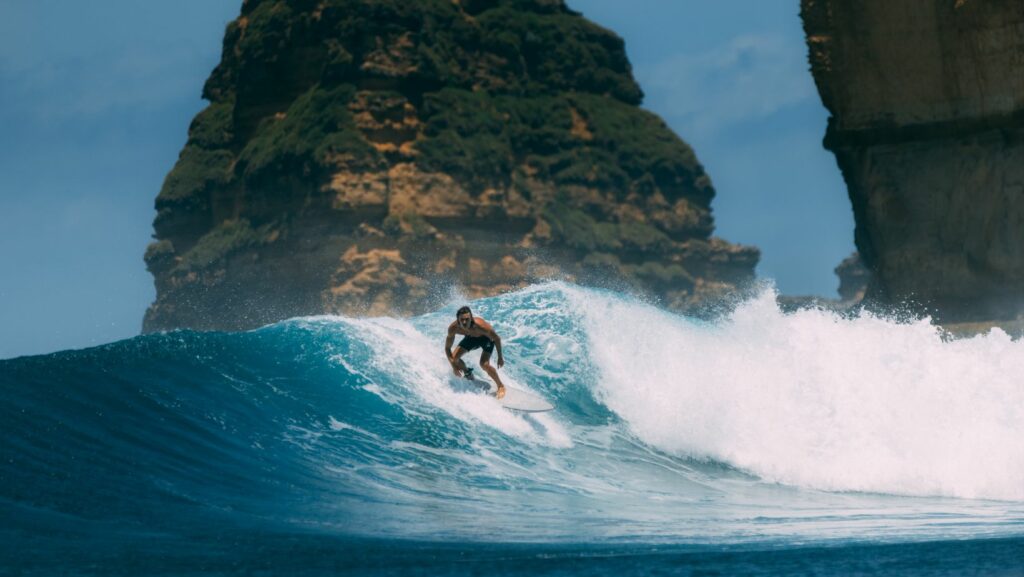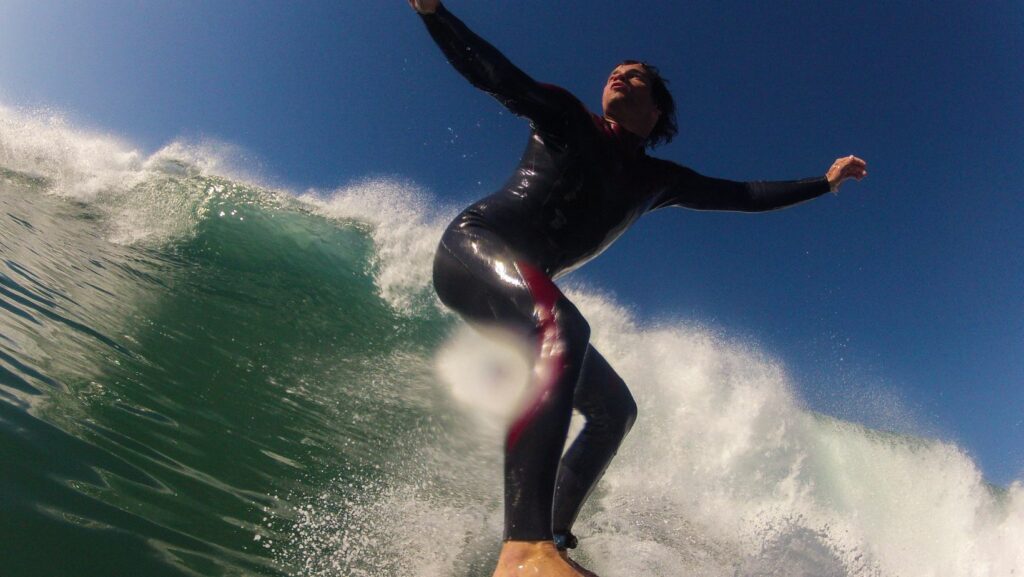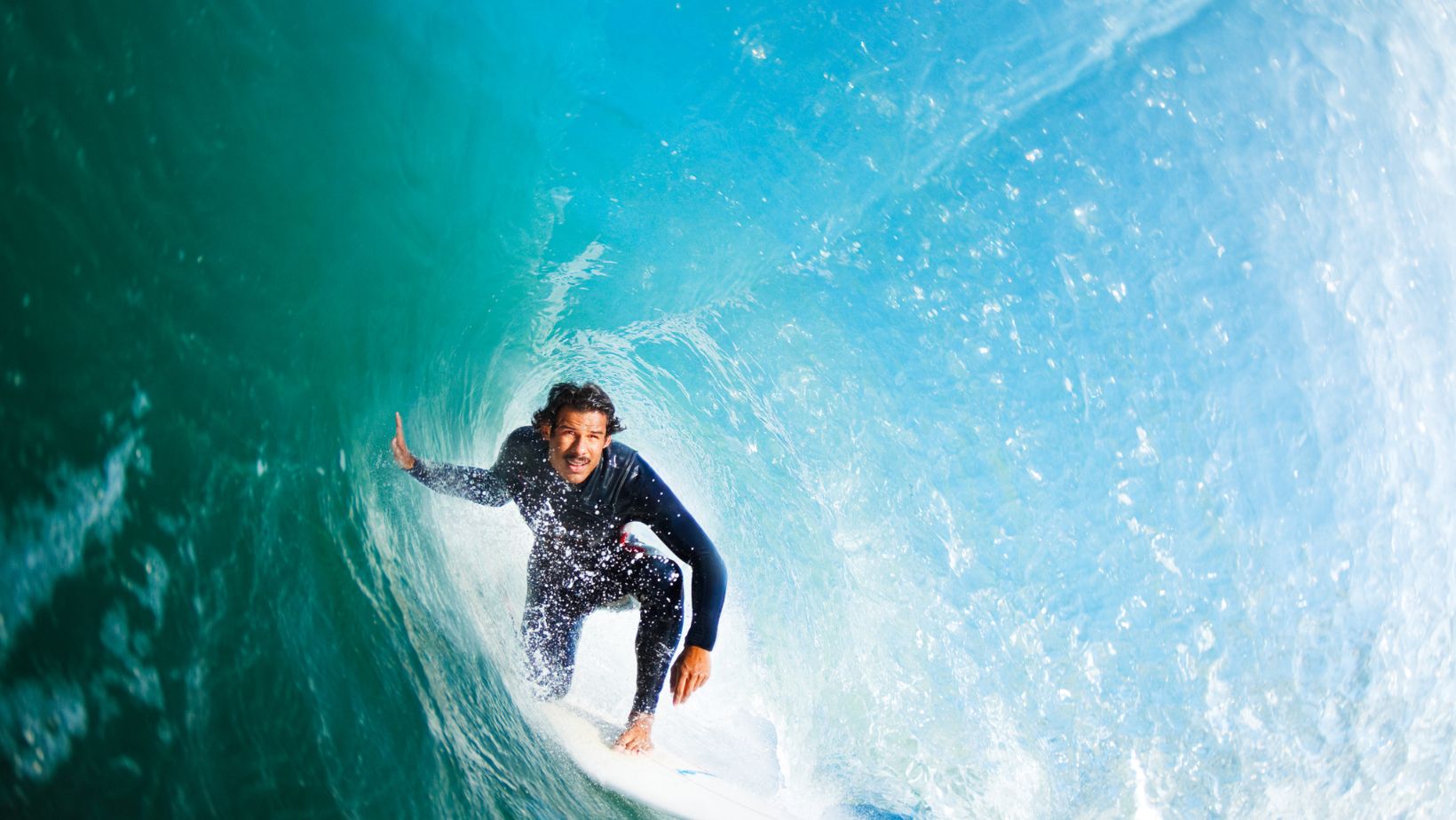What are Ocean Waves?
Though they are ubiquitous and easily recognised, the physical properties of waves are often misunderstood. So, what exactly are waves and how do they form?
A wave, in its most basic definition, is a disturbance that moves energy through a medium without actually displacing the medium. For example, when you skip a stone across the surface of a pond, you create ripples that radiate outward from the point of impact. These ripples are an example of a transverse wave; the water molecules vibrate at a right angle to the direction in which the wave is moving. Another example of a wave is if you were to drop a pebble into a bucket of water; the resulting circles spreading outward would be an example of a longitudinal wave. In this instance, the water molecules vibrate in the same direction as the wave is moving.
Waves form when water molecules are set in motion. The most frequent way this occurs is when wind blows over the surface of the ocean. As air particles hit water molecules, they give some of their kinetic energy (energy from motion) to them. The process continues as long as there is wind blowing across the water’s surface; more and more water molecules gain kinetic energy and start to move around, bumping into other molecules and setting them in motion too. This domino effect eventually leads to groups of moving water molecules called waves.
The Different Types of Ocean Waves
There are three main types of ocean waves that surfers ride- wind waves, ground swells, and swells. Wind waves are created by the wind blowing across the surface of the water. The size of the wind wave is determined by the strength of the wind, the fetch (the distance that the wind blows across the water), and the duration of time that the wind blows. Ground swells are created by large disturbances in deep water, such as storms. These waves can travel for thousands of miles and can take days to reach shore. Swells are a combination of both wind waves and ground swells.

The three primary types of ocean waves are:
-Wind Waves: The wind blowing across the surface of the water creates these. The size of the wave is determined by the strength of the wind, The fetch (the distance that the wind blows across the water), and The duration of time that the wind blows.
- Ground Swells: These waves are caused by large disturbances in deep water, such as storms. These waves can travel for thousands of miles and can take days to reach shore.
- Swells: These comprise of both wind waves and ground swells.
What are Surf Waves?
The wind creates waves on the water’s surface as it blows across it. The size and power of a wave is determined by the strength of the wind, the fetch (the distance over which the wind blows), and the duration of the blowing. Waves that are generated in deep water by a distant storm will usually be large and long, while those from a close-by storm will generally be smaller and shorter.
There are three primary types of waves that surfers ride – point breaks, reef breaks, and beach breaks. The surfing experience and level of difficulty are both impacted by the unique characteristics of each wave type.
Point break waves form when swell waves crash into a point of land extending into the water. The point acts as a barrier, making the waves break both to the left and right. Point break waves are often lengthy and smooth, making them ideal for beginners and intermediates.
Reef break waves form when swell waves hit a reef or shallow area of rocks below the water’s surface. These waves can break both left and right, but they are often more powerful than point break waves. Reef break waves are usually shorter than point break waves and often have a hollow shape, making them more difficult to ride.
Beach break waves are created when swell waves come into contact with a beach or shoreline. The size and power of beach break waves can differ significantly based on factors such as the angle of the shoreline and the presence of sandbars. Usually, beach breakwaves have a short, choppy shape, which makes them more challenging to ride than other types of surf waves.
The Different Types of Surf Waves
There are various types of waves while surfing that present different difficulties. To be able to ride them properly, surfers must be conscious of these different types of surf waves. Here is a guide to the various types of surf waves:

Green waves are the most typical type of wave and usually the simplest to ride. They form when the wind is blowing from land out to sea, resulting in a smooth, rolling wave.
- White water waves: These waves are created when the wind is blowing towards the shore, causing the wave to break earlier than it would normally. These waves can be more challenging to ride, but they offer a great opportunity for beginners to practice their skills.
- Pipeline waves: These waves only show up in specific places, like Hawaii’s Banzai pipeline. They are incredibly powerful and can be risky, so only expert surfers should try to ride them.
When a Surfer Rides an Ocean Wave on Her Surfboard, she is Actually Riding On
Picking The Right Wave
Catching different types of waves necessitates diverse methods and skills. To catch a wave, a surfer must paddle with their arms until they are going the same speed as the wave. Once they have reached this point, they stand up on their board and ride the wave. The kind of surfboard being used also plays a role in how the wave is ridden.
The four main types of waves surfers ride are:
- Point Break Waves: These waves form when the wind blows offshore (away from the shore), creating a long, smooth, powerful wave. Point break waves are ideal for surfing because they allow for lengthy rides with plenty of turns.
- Beach Break Waves: These waves form when the wind blows towards the shore, resulting in a shorter, choppier wave. Beach break waves can be more challenging to surf because they often break quickly and without warning.
- Reef Break Waves: These waves form when the swell hits a reef or rocks underwater, resulting in a very powerful wave that breaks suddenly and forcefully. Reef break waves can be extremely dangerous for surfers because they could be thrown against the reef or rocks.
- Tube Waves: These waves form when swell hits an obstruction, such as a sandbar or reef, and creates a hollow “tube” or “barrel.” Tube waves are often thought of as the perfect wave for surfing because they offer a long, smooth ride with plenty of time to perform tricks.
The Right Equipment
The following things are necessary to go surfing: a surfboard, wax, and a wet suit if the water is cold. Most beaches that offer surfing have the option to buy or rent this equipment.
The surfboard is the most crucial piece of equipment. It is available in many shapes and sizes, and the ideal board for you depends on your level of experience, weight, and height. After you’ve found the perfect board, you’ll need to wax it. Wax prevents you from slipping off the board by giving you a better grip.
You’ll need a wet suit to surf in cold water as well. They work by trapping a layer of water next to your skin to heat up from your body temperature. This creates a barrier between you and the frigid water.
The Right Technique
Different types of waves, of course, present different difficulties and necessitate diverse techniques to ride them. Nevertheless, there are three primary ways to ride a wave:
1. Paddleboarding
The most frequent method of surfing is also the most straightforward: you paddle out into the ocean on your surfboard until you reach a wave, then lie or kneel on your board and paddle rapidly to catch the wave. As the wave catches up to you, stand up and ride it in!
2. Body surfing is a great way to stay in shape and have fun at the same time.
If you don’t have a surfboard or are feeling lazy, body surfing is always an option. To do this, lie on your stomach in the water and paddle with your hands to catch a wave. Then, use your body weight and momentum to ride the wave in!
3. Surfing that involves being towed into the waves by a boat or jet ski.
This is a more advanced technique used by experienced surfers. To towed-in surf, you need to be towed behind a boat or jet ski until you reach a good wave. Then you can drop into the wave and ride it in!
Though they are ubiquitous and easily recognised, the physical properties of waves are often misunderstood. So, what exactly are waves and how do they form?
A wave, in its most basic definition, is a disturbance that moves energy through a medium without actually displacing the medium. For example, when you skip a stone across the surface of a pond, you create ripples that radiate outward from the point of impact. These ripples are an example of a transverse wave; the water molecules vibrate at a right angle to the direction in which the wave is moving. Another example of a wave is if you were to drop a pebble into a bucket of water; the resulting circles spreading outward would be an example of a longitudinal wave. In this instance, the water molecules vibrate in the same direction as the wave is moving.
Waves form when water molecules are set in motion. The most frequent way this occurs is when wind blows over the surface of the ocean. As air particles hit water molecules, they give some of their kinetic energy (energy from motion) to them. The process continues as long as there is wind blowing across the water’s surface; more and more water molecules gain kinetic energy and start to move around, bumping into other molecules and setting them in motion too. This domino effect eventually leads to groups of moving water molecules called waves.
The Different Types of Ocean Waves
There are three main types of ocean waves that surfers ride- wind waves, ground swells, and swells. Wind waves are created by the wind blowing across the surface of the water. The size of the wind wave is determined by the strength of the wind, the fetch (the distance that the wind blows across the water), and the duration of time that the wind blows. Ground swells are created by large disturbances in deep water, such as storms. These waves can travel for thousands of miles and can take days to reach shore. Swells are a combination of both wind waves and ground swells.
The three primary types of ocean waves are:
-Wind Waves: The wind blowing across the surface of the water creates these. The size of the wave is determined by the strength of the wind, The fetch (the distance that the wind blows across the water), and The duration of time that the wind blows.
- Ground Swells: These waves are caused by large disturbances in deep water, such as storms. These waves can travel for thousands of miles and can take days to reach shore.
- Swells: These comprise of both wind waves and ground swells.
What are Surf Waves?
The wind creates waves on the water’s surface as it blows across it. The size and power of a wave is determined by the strength of the wind, the fetch (the distance over which the wind blows), and the duration of the blowing. Waves that are generated in deep water by a distant storm will usually be large and long, while those from a close-by storm will generally be smaller and shorter.
There are three primary types of waves that surfers ride – point breaks, reef breaks, and beach breaks. The surfing experience and level of difficulty are both impacted by the unique characteristics of each wave type.
Point break waves form when swell waves crash into a point of land extending into the water. The point acts as a barrier, making the waves break both to the left and right. Point break waves are often lengthy and smooth, making them ideal for beginners and intermediates.
Reef break waves form when swell waves hit a reef or shallow area of rocks below the water’s surface. These waves can break both left and right, but they are often more powerful than point break waves. Reef break waves are usually shorter than point break waves and often have a hollow shape, making them more difficult to ride.
Beach break waves are created when swell waves come into contact with a beach or shoreline. The size and power of beach break waves can differ significantly based on factors such as the angle of the shoreline and the presence of sandbars. Usually, beach breakwaves have a short, choppy shape, which makes them more challenging to ride than other types of surf waves.
The Different Types of Surf Waves
There are various types of waves while surfing that present different difficulties. To be able to ride them properly, surfers must be conscious of these different types of surf waves. Here is a guide to the various types of surf waves:
Green waves are the most typical type of wave and usually the simplest to ride. They form when the wind is blowing from land out to sea, resulting in a smooth, rolling wave.
- White water waves: These waves are created when the wind is blowing towards the shore, causing the wave to break earlier than it would normally. These waves can be more challenging to ride, but they offer a great opportunity for beginners to practice their skills.
- Pipeline waves: These waves only show up in specific places, like Hawaii’s Banzai pipeline. They are incredibly powerful and can be risky, so only expert surfers should try to ride them.
When a Surfer Rides an Ocean Wave on Her Surfboard, she is Actually Riding On
Picking The Right Wave
Catching different types of waves necessitates diverse methods and skills. To catch a wave, a surfer must paddle with their arms until they are going the same speed as the wave. Once they have reached this point, they stand up on their board and ride the wave. The kind of surfboard being used also plays a role in how the wave is ridden.
The four main types of waves surfers ride are:
- Point Break Waves: These waves form when the wind blows offshore (away from the shore), creating a long, smooth, powerful wave. Point break waves are ideal for surfing because they allow for lengthy rides with plenty of turns.
- Beach Break Waves: These waves form when the wind blows towards the shore, resulting in a shorter, choppier wave. Beach break waves can be more challenging to surf because they often break quickly and without warning.
- Reef Break Waves: These waves form when the swell hits a reef or rocks underwater, resulting in a very powerful wave that breaks suddenly and forcefully. Reef break waves can be extremely dangerous for surfers because they could be thrown against the reef or rocks.
- Tube Waves: These waves form when swell hits an obstruction, such as a sandbar or reef, and creates a hollow “tube” or “barrel.” Tube waves are often thought of as the perfect wave for surfing because they offer a long, smooth ride with plenty of time to perform tricks.
The Right Equipment
The following things are necessary to go surfing: a surfboard, wax, and a wet suit if the water is cold. Most beaches that offer surfing have the option to buy or rent this equipment.
The surfboard is the most crucial piece of equipment. It is available in many shapes and sizes, and the ideal board for you depends on your level of experience, weight, and height. After you’ve found the perfect board, you’ll need to wax it. Wax prevents you from slipping off the board by giving you a better grip.
You’ll need a wet suit to surf in cold water as well. They work by trapping a layer of water next to your skin to heat up from your body temperature. This creates a barrier between you and the frigid water.
The Right Technique
Different types of waves, of course, present different difficulties and necessitate diverse techniques to ride them. Nevertheless, there are three primary ways to ride a wave:
1. Paddleboarding
The most frequent method of surfing is also the most straightforward: you paddle out into the ocean on your surfboard until you reach a wave, then lie or kneel on your board and paddle rapidly to catch the wave. As the wave catches up to you, stand up and ride it in!
2. Body surfing is a great way to stay in shape and have fun at the same time.
If you don’t have a surfboard or are feeling lazy, body surfing is always an option. To do this, lie on your stomach in the water and paddle with your hands to catch a wave. Then, use your body weight and momentum to ride the wave in!
3. Surfing that involves being towed into the waves by a boat or jet ski.
This is a more advanced technique used by experienced surfers. To towed-in surf, you need to be towed behind a boat or jet ski until you reach a good wave. Then you can drop into the wave and ride it in!


